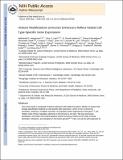Histone Modifications at Human Enhancers Reflect Global Cell-Type-Specific Gene Expression
Author(s)
Heintzman, Nathaniel D.; Hon, Gary C.; Hawkins, R. David; Kheradpour, Pouya; Stark, Alexander; Harp, Lindsey F.; Ye, Zhen; Lee, Leonard K.; Stuart, Rhona K.; Ching, Christina W.; Ching, Keith A.; Antosiewicz-Bourget, Jessica E.; Liu, Hui; Zhang, Xinmin; Green, Roland D.; Lobanenkov, Victor V.; Stewart, Ron; Thomson, James A.; Crawford, Gregory E.; Kellis, Manolis; Ren, Bing; ... Show more Show less
DownloadKellis_Histone Modifications.pdf (2.797Mb)
OPEN_ACCESS_POLICY
Open Access Policy
Creative Commons Attribution-Noncommercial-Share Alike
Terms of use
Metadata
Show full item recordAbstract
The human body is composed of diverse cell types with distinct functions. Although it is known that lineage specification depends on cell-specific gene expression, which in turn is driven by promoters, enhancers, insulators and other cis-regulatory DNA sequences for each gene1, 2, 3, the relative roles of these regulatory elements in this process are not clear. We have previously developed a chromatin-immunoprecipitation-based microarray method (ChIP-chip) to locate promoters, enhancers and insulators in the human genome4, 5, 6. Here we use the same approach to identify these elements in multiple cell types and investigate their roles in cell-type-specific gene expression. We observed that the chromatin state at promoters and CTCF-binding at insulators is largely invariant across diverse cell types. In contrast, enhancers are marked with highly cell-type-specific histone modification patterns, strongly correlate to cell-type-specific gene expression programs on a global scale, and are functionally active in a cell-type-specific manner. Our results define over 55,000 potential transcriptional enhancers in the human genome, significantly expanding the current catalogue of human enhancers and highlighting the role of these elements in cell-type-specific gene expression.
Date issued
2009-03Department
Massachusetts Institute of Technology. Computer Science and Artificial Intelligence Laboratory; Massachusetts Institute of Technology. Department of Electrical Engineering and Computer ScienceJournal
Nature
Publisher
Nature Publishing Group
Citation
Heintzman, Nathaniel D. et al. “Histone Modifications at Human Enhancers Reflect Global Cell-type-specific Gene Expression.” Nature 459.7243 (2009): 108–112.
Version: Author's final manuscript
ISSN
0028-0836
1476-4687